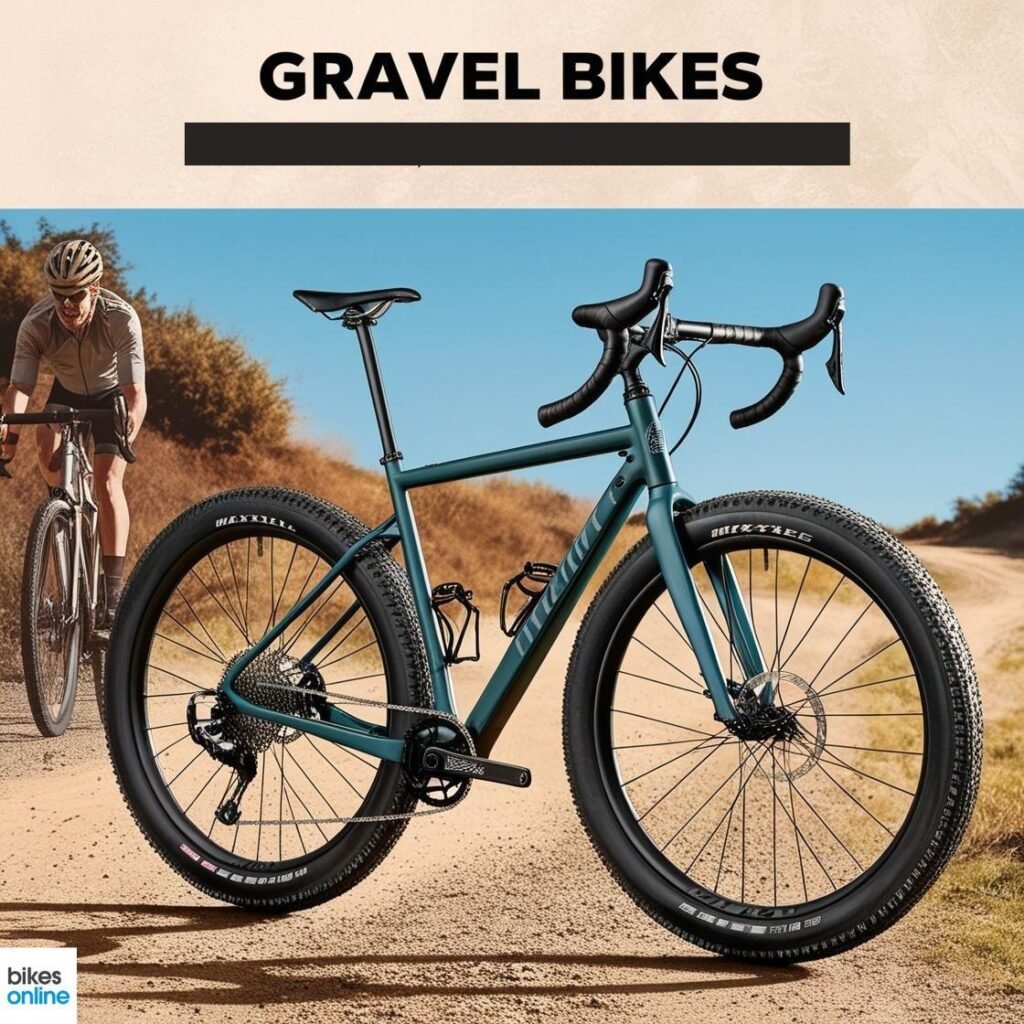
Cycling has surged in popularity as a versatile form of exercise, transportation, and leisure, drawing enthusiasts from all walks of life. This increase in interest has spurred the development and refinement of various bike types, each tailored to different riding preferences and terrains. From sleek road bikes designed for speed to rugged mountain bikes built for off-road challenges, the options are more diverse than ever. Among these, gravel bikes have emerged as a popular choice for riders looking for a blend of versatility and durability. In this article, we’ll dive into a detailed comparison between gravel bikes, road bikes, and mountain bikes, examining their design, performance, and suitability for different types of cyclists. Whether you’re a seasoned rider or new to the cycling world, understanding these differences can help you make a more informed decision about which bike best fits your cycling adventures.

What Are Gravel Bikes?
Gravel bikes, often described as the Swiss Army knife of the cycling world, are engineered to bridge the gap between road bikes and mountain bikes. They are designed to handle a variety of surfaces, from paved roads to gravel paths and even light trails.
A gravel bike is a type of bicycle specifically built to tackle mixed terrain with greater comfort and capability than a standard road bike while being faster and more efficient on open trails than a typical mountain bike.
Key Features:
- Frame Geometry: Gravel bikes have a unique frame geometry that combines the responsive handling of a road bike with the robustness of a mountain bike. This includes a longer wheelbase and a more upright riding position, which offers stability and comfort on uneven surfaces.
- Tires: The tires on a gravel bike are wider than those on road bikes, typically ranging from 35mm to 45mm. This increased width provides better traction and stability on loose surfaces while still maintaining reasonable speed on paved roads.
- Versatility: Gravel bikes are equipped with features that enhance their adaptability, such as clearance for multiple tire sizes, mounts for bike packing gear, and disc brakes for reliable stopping power in all conditions.
Ideal Use Cases and Typical Terrain:
- Use Cases: Gravel bikes are ideal for riders who enjoy long rides that don’t confine them to a single type of terrain. They are perfect for adventure cycling, bike packing, and endurance events that traverse various surfaces.
- Typical Terrain: These bikes excel on gravel roads, dirt tracks, forest service roads, and gentle off-road trails. They are also capable on paved roads, though they are not as fast as dedicated road bikes, offering a good compromise for riders looking to explore beyond the tarmac.
Road Bikes Explained
Road bikes are designed for speed and efficiency on paved surfaces, making them a popular choice for competitive racing and long-distance riding on asphalt.
A road bike is a bicycle built for traveling at high speeds on paved roads. Characterized by its lightweight frame, thin tires, and aggressive positioning, the road bike is optimized for performance and endurance over flat or rolling terrain.
Primary Characteristics:
- Lightweight Frame: Typically made from materials like carbon fiber or aluminum, road bike frames are designed to be as light as possible to enhance speed and ease of climbing.
- Thin Tires: Road bikes use narrow tires, usually around 23mm to 28mm in width, which reduce rolling resistance and increase speed.
- Aggressive Positioning: The geometry of a road bike encourages a forward-leaning riding position. This aerodynamic posture minimizes air resistance and maximizes speed.
Focus on Speed and Aerodynamics:
- Road bikes emphasize aerodynamic efficiency to allow riders to sustain high speeds with less effort. Features like dropped handlebars help achieve a lower and more streamlined position.
- The overall design is focused on minimizing drag—everything from the frame’s shape to the components is engineered to cut through the air more efficiently.
Best Environments for Road Biking:
- Paved Roads: Smooth asphalt provides the ideal surface for road biking, where the bike’s design can be fully utilized to achieve and maintain high speeds.
- Racing Circuits and Long-Distance Routes: Road bikes perform best in scenarios where the terrain is relatively flat and consistent, such as in road races or on century rides where endurance and speed are tested over long distances.
Mountain Bikes Overview
Mountain bikes are built to handle rugged terrain and provide stability and comfort through challenging landscapes, making them ideal for off-road adventures.
Mountain bikes are designed to endure the rough and unpredictable conditions of off-road trails. They are built with durability and performance in mind, able to withstand impacts and provide traction on a variety of surfaces.
Robust Design:
- Sturdy Frame: The frames of mountain bikes are typically made from materials like steel or reinforced aluminum, offering increased durability and strength to handle bumps, drops, and collisions.
- Wide Handlebars: Wider handlebars offer greater control and leverage, which is essential for navigating through tight turns and over obstacles.
Key Features:
- Suspension: Most mountain bikes come equipped with front and/or full suspension systems. These systems help absorb the shocks from rough terrain, improving comfort and maintaining control.
- Tire Tread and Width: Tires on mountain bikes are significantly wider and have deeper treads than those on road or gravel bikes. This design increases grip and stability on loose and uneven surfaces such as mud, gravel, and rocks.
Terrain and Conditions Best Suited for Mountain Biking:
- Off-Road Trails and Mountain Paths: Mountain bikes excel on trails that are too rough for road or gravel bikes. This includes paths filled with rocks, roots, and steep gradients.
- Variable Weather Conditions: The robust nature of mountain bikes also makes them well-suited for riding in adverse weather conditions, where mud and wet surfaces require extra grip and stability.
Performance Comparison
This section delves into how gravel, road, and mountain bikes perform across various metrics such as handling, speed, and durability, providing a comparative insight into each bike type’s strengths and weaknesses.
Handling and Comfort
- Gravel Bikes: Known for their versatility, gravel bikes offer a balance between comfort and responsiveness. They handle well on mixed terrains, from tarmac to trail, thanks to their wider tires and relaxed geometry which also provide increased comfort on longer rides.
- Road Bikes: With a focus on speed and agility, road bikes offer precise handling on paved surfaces but can be uncomfortable on non-paved surfaces due to their stiff frames and thin tires. They are best suited for smooth asphalt where handling sharp turns and maintaining high speeds is crucial.
- Mountain Bikes: These bikes excel in handling rugged, uneven terrains where control and stability are paramount. The wide tires and suspension systems significantly enhance comfort on rough trails, making them ideal for challenging off-road conditions.
Speed and Efficiency
- Gravel Bikes: While not as fast as road bikes on pavement, gravel bikes are more efficient than mountain bikes when transitioning between different surfaces. They provide a good compromise for riders looking to maintain moderate speed across diverse terrains.
- Road Bikes: Unmatched in terms of speed and efficiency on paved roads, road bikes are designed for peak aerodynamic performance, making them the fastest type among the three on smooth surfaces.
- Mountain Bikes: Although they are not built for speed, mountain bikes are highly efficient in terms of energy transfer and power when it comes to climbing steep slopes and navigating technical sections where slower, more powerful strokes are necessary.
Durability and Maintenance
- Gravel Bikes: Gravel bikes are built to be durable but not as heavy-duty as mountain bikes. They require regular maintenance, especially for components like brakes and tires that wear out due to mixed-surface usage.
- Road Bikes: Typically, road bikes require high maintenance to keep their lightweight components in optimal condition. Their performance can be significantly impacted by even minor wear and tear, especially on the lightweight wheels and tires.
- Mountain Bikes: Designed to withstand tough conditions, mountain bikes are the most durable. However, their complex suspension systems and rugged build mean that they can require more frequent maintenance checks and repairs to keep everything running smoothly.
Pros and Cons
Understanding the advantages and disadvantages of gravel, road, and mountain bikes can help riders choose the bike that best fits their specific cycling needs and preferences.
Gravel Bikes
- Advantages:
- Versatility: Gravel bikes are extremely adaptable, capable of handling everything from paved roads to moderate off-road trails. This makes them an excellent choice for riders who enjoy exploring a variety of terrains.
- Comfort: With their upright geometry and wider tires, gravel bikes provide a more comfortable ride over longer distances and rough surfaces compared to road bikes.
- Disadvantages:
- Speed Limitations: While they are faster than mountain bikes on paved roads, gravel bikes are not as quick as road bikes due to their heavier build and wider tires.
- Off-Road Limitations: Although capable on light trails, gravel bikes lack the robust construction needed for more extreme off-road conditions that mountain bikes can handle.
Road Bikes
- Advantages:
- Speed: Road bikes are optimized for speed, with aerodynamic frames and lightweight components that make them the fastest type on smooth surfaces.
- Lightweight: The use of materials like carbon fiber and aluminum makes road bikes easy to handle and quick to accelerate.
- Disadvantages:
- Terrain Limitations: The narrow tires and stiff frames of road bikes are not designed for rough terrains, making them unsuitable for gravel or off-road paths.
- Comfort: The aggressive riding position and hard seating can be uncomfortable during long rides or on uneven surfaces.
Mountain Bikes
- Advantages:
- Rough Terrain Suitability: Mountain bikes are built to handle tough terrains with ease, featuring robust frames and advanced suspension systems.
- Control: Wider tires and stable designs offer better control in challenging off-road conditions, enhancing safety and performance.
- Disadvantages:
- Weight: Mountain bikes are generally heavier, which can make them more challenging to transport and slower on flat terrains.
- Speed: Due to their weight and tire tread, mountain bikes are slower on paved roads compared to gravel and road bikes.
How to Choose the Right Bike for You
Choosing the right bike involves more than just liking its look or feel; it requires considering how the bike will perform under your specific conditions and needs. Here are some critical factors to think about and some tips on how to test bikes before making your final decision.
Factors to Consider
- Terrain: Consider the most common type of terrain you plan to ride on. Road bikes are ideal for paved roads and racing tracks, while mountain bikes are suited for rough, off-road trails. Gravel bikes are excellent for those who ride on a mix of terrains.
- Usage Frequency: How often you plan to ride your bike also plays a crucial role. If you are a daily commuter, durability and comfort are key aspects to look for. For occasional riders, a more versatile and easy-to-maintain bike might be preferable.
- Comfort: Long rides require a bike that doesn’t strain your body. Check for bikes with adjustable features that fit your body comfortably, and consider the type of saddle, the frame geometry, and handlebar position.
- Budget: Set a realistic budget considering not only the initial purchase price but also the maintenance costs. Higher-end bikes are more costly but offer better performance and longevity. Decide how much you are willing to invest for the quality and features you need.
Tips on Testing Bikes Before Purchase
- Test Rides: Always test ride a bike before you buy it. This is the best way to get a feel for how it handles and whether it suits your riding style. Try different models and types to compare.
- Fit and Sizing: Make sure the bike fits you properly. Check the seat height, reach to the handlebars, and comfort of the riding position. A bike shop can help adjust these settings during your test ride.
- Component Quality: Pay attention to the quality of components, including brakes, gears, and suspension. Reliable components not only improve the ride experience but also reduce maintenance costs down the line.
- Seek Advice: Don’t hesitate to ask for advice from experienced cyclists or sales personnel in bike shops. They can provide insights into the reliability and performance of different bike models and brands.
Taking the time to consider these factors and properly testing potential bikes can lead to a more satisfying and effective cycling experience, ensuring that you choose the bike that best fits your lifestyle and cycling needs.
Also Check: Road Bike vs Gravel Bike: Key Differences & Best Choice
Conclusion
In this comprehensive guide, we’ve explored the distinct features, advantages, and disadvantages of gravel bikes, road bikes, and mountain bikes. Each type offers unique benefits tailored to different terrains and riding preferences:
- Gravel Bikes: Known for their versatility and comfort, these bikes are ideal for those who traverse a variety of terrains but don’t require the extreme capabilities of mountain bikes or the high-speed performance of road bikes.
- Road Bikes: Best suited for high-speed cycling on paved roads, these bikes are perfect for enthusiasts looking to improve their speed and efficiency in road races or recreational cycling on asphalt.
- Mountain Bikes: With their robust design and advanced suspension systems, these bikes are the go-to choice for riders tackling rough, off-road trails, providing superior control and durability in rugged conditions.
Choosing the right bike involves more than just assessing technical specifications—it’s about matching your personal riding habits, terrain, and comfort needs with the right type of bike. We encourage all riders, from beginners to seasoned cyclists, to carefully consider their personal requirements, test different bikes, and seek expert advice when selecting a new bike. By doing so, you can ensure that your cycling experience is both enjoyable and aligned with your lifestyle and goals.
Meet Sachin Kumar, an avid cyclist and bike enthusiast with a passion for two-wheeled adventures. At our Turinbikes site, Sachin shares expert insights, thrilling ride experiences, and tips for fellow bike lovers.






